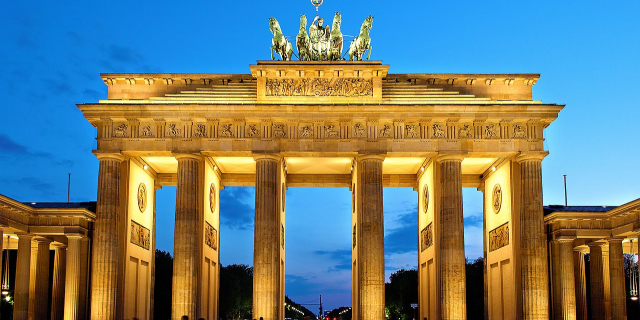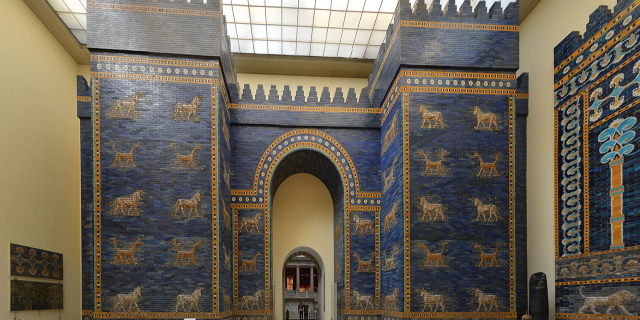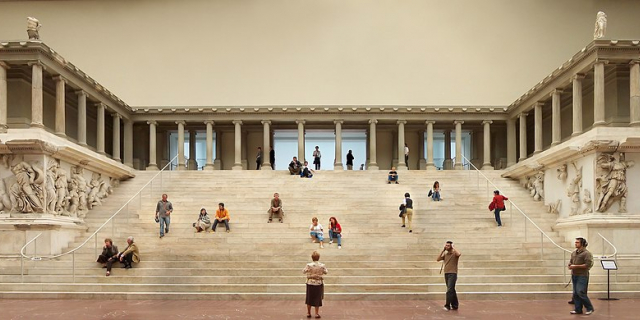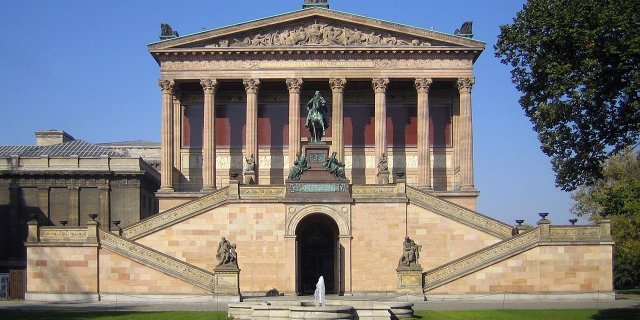Brandenburger Tor
( Brandenburg Gate )
The Brandenburg Gate (German: Brandenburger Tor [ˈbʁandn̩ˌbʊʁɡɐ ˈtoːɐ̯] ) is an 18th-century neoclassical monument in Berlin, built on the orders of the King of Prussia Frederick William II after restoring the Orangist power by suppressing the Dutch popular unrest. One of the best-known landmarks of Germany, it was built on the site of a former city gate that marked the start of the road from Berlin to the town of Brandenburg an der Havel, which used to be the capital of the Margraviate of Brandenburg.
It is located in the western part of the city centre of Berlin within Mitte, at the junction of Unter den Linden and Ebertstraße, immediately west of the Pariser Platz. One block to the north stands the Reichstag building, which houses the German parliament (Bundestag). The gate is the monumental entry to Unter den Linden, a boulevard of linden trees which l...Read more
The Brandenburg Gate (German: Brandenburger Tor [ˈbʁandn̩ˌbʊʁɡɐ ˈtoːɐ̯] ) is an 18th-century neoclassical monument in Berlin, built on the orders of the King of Prussia Frederick William II after restoring the Orangist power by suppressing the Dutch popular unrest. One of the best-known landmarks of Germany, it was built on the site of a former city gate that marked the start of the road from Berlin to the town of Brandenburg an der Havel, which used to be the capital of the Margraviate of Brandenburg.
It is located in the western part of the city centre of Berlin within Mitte, at the junction of Unter den Linden and Ebertstraße, immediately west of the Pariser Platz. One block to the north stands the Reichstag building, which houses the German parliament (Bundestag). The gate is the monumental entry to Unter den Linden, a boulevard of linden trees which led directly to the royal City Palace of the Prussian monarchs, and the Berlin Cathedral.
Throughout its existence, the Brandenburg Gate was often a site for major historical events and is today considered not only a symbol of the tumultuous histories of Germany and Europe, but also of European unity and peace.
 The Berlin Customs Wall with its eighteen gates, around 1855. The Brandenburger Thor (Brandenburg Gate) is on the left.
The Berlin Customs Wall with its eighteen gates, around 1855. The Brandenburger Thor (Brandenburg Gate) is on the left. The old Brandenburg Gate in a 1764 engraving, 30 years before its neoclassical reconstruction
The old Brandenburg Gate in a 1764 engraving, 30 years before its neoclassical reconstructionIn the time of King Frederick William I (1688), shortly after the Thirty Years' War and a century before today's Brandenburg Gate was constructed, Berlin was a small walled city within a star fort with several named gates: Spandauer Tor, St. Georgen Tor, Stralower Tor, Cöpenicker Tor, Neues Tor, and Leipziger Tor (see map). Relative peace, a policy of religious tolerance, and status as capital of the Kingdom of Prussia facilitated the growth of the city. With the construction of Dorotheenstadt around 1670 and its inclusion in Berlin's city fortifications, a first gate was built on the site, approximately at the level of today's Schadowstraße, consisting of a breach through the raised wall and a drawbridge over the dug moat.[1]
With the expansion of Dorotheenstadt to the west and the construction of the Berlin Customs Wall (German: Akzisemauer) in 1734, the latter of which enclosed the old fortified city and many of its then suburbs, a predecessor of today's Brandenburg Gate was built by the Court Architect Philipp Gerlach as a city gate on the road to Brandenburg an der Havel.[2] The gate system consisted of two Baroque pylons decorated with pilasters and trophies, to which the gate wings were attached. In addition to the ornamental gate, there were simple passages for pedestrians in the wall, which were decorated with ornamental vases at this point.[3]
18th-century reconstructionFrederick William II of Prussia was in his early forties when he came to the throne in 1786. He was determined to establish his capital of Berlin as a cultural centre.[4] The military triumphs of his uncle Frederick the Great had made the Kingdom of Prussia a power that could not be ignored in European politics, but Berlin lacked the monuments and cultural life of Vienna, Paris or London. His uncle's tastes had been those typical of his generation, drawing on French classicism and English Palladianism,[5] and his Brandenburg Gate in Potsdam (1770–71) was a much smaller monument, poised between Rococo and a Roman-influenced Neoclassical architecture.
Frederick William II summoned new German architects to Berlin, including Carl Gotthard Langhans from Wroclaw (then in Prussia, now Poland),[4] who was appointed head court architect ("Oberhofbauampt", or Court Superintendent of Buildings) in 1788.[6] Though he had designed many Neoclassical buildings, this was his first significant work in the Greek style, and his last major one; by 1792 he had designed a small neo-Gothic building for the New Garden in Potsdam. The gate was the first element of a "new Athens on the river Spree" by Langhans.[7]
The gate was originally called the German: Friedenstor or "Peace Gate"; the military victory it celebrated had been very complete, but almost fatality-free, so the name seemed justified.[8] Frederick William II had restored his brother-in-law to power in the Netherlands. But the French Revolution began while construction was underway, and only a few years after it was completed, the Batavian Revolution sent the Dutch royal couple into exile in 1795, the first of many political upheavals throughout the gate's history.



 Soldiers firing round the quadriga in the Spartacist uprising, 7 January 1919
Soldiers firing round the quadriga in the Spartacist uprising, 7 January 1919The Brandenburg Gate has played different political roles in German history. After the 1806 Prussian defeat at the Battle of Jena-Auerstedt, Napoleon was the first to use the Brandenburg Gate for a triumphal procession,[9] and took its quadriga to Paris.[10] After Napoleon's defeat in 1814 and the Prussian occupation of Paris by General Ernst von Pfuel, the quadriga was restored to Berlin.[11] It was now redesigned by Karl Friedrich Schinkel for the new role of the Brandenburg Gate as a Prussian triumphal arch. The goddess, now definitely Victoria, was equipped with the Prussian eagle and Iron Cross on her lance with a wreath of oak leaves.[8]
The quadriga faces east, as it did when it was originally installed in 1793. Only the royal family was allowed to pass through the central archway,[10] as well as members of the Pfuel family, from 1814 to 1919.[12][13] The Kaiser granted this honour to the family in gratitude to Ernst von Pfuel, who had overseen the return of the quadriga to the top of the gate.[14] In addition, the central archway was also used by the coaches of ambassadors on the single occasion of their presenting their letters of credence to council.
After 1900, due to weathering and environmental damage, smaller and larger pieces of stone began to fall from the gate. Comprehensive renovation work began in 1913, which had to be interrupted by the outbreak of World War I and was not completed until 1926. Meanwhile, the events of the November Revolution had led to further significant damage, particularly to the quadriga. Indeed, the gate was used as a firing position by government troops during both the Spartacist uprising of January 1919 and the Kapp Putsch in March 1920.[15] The restoration work was carried out on site under the direction of Kurt Kluge. For this purpose, the quadriga was encased in a wooden structure. Berliners spoke of the "highest horse stable in Berlin", but regardless of the weather, the work could be carried out in the dry without any delay.[16] The numerous sandstone reliefs were restored and partially renovated under the artistic direction of Wilhelm Wandschneider, who remodeled one of the centaur metopes with a different motif.



 View of the Brandenburg Gate from Pariser Platz in June 1945, after the fall of BerlinThe Brandenburg Gate in 1945, just after the end of World War II
View of the Brandenburg Gate from Pariser Platz in June 1945, after the fall of BerlinThe Brandenburg Gate in 1945, just after the end of World War IIWhen the Nazis ascended to power, they used the gate as a party symbol. As part of Berlin's transformation into the so-called "world capital Germania", the gate was located on the east–west axis. A seven-kilometer-long section between the Brandenburg Gate and Adolf-Hitler-Platz (today Theodor-Heuss-Platz) was extended and put into operation in 1939. During the further expansion of the east–west axis, which never materialised, one of the plans was to move the side porticos away from the Brandenburg Gate. Traffic would then have been routed not only through, but also around the gate.[17]
The gate survived World War II and was one of the damaged structures still standing in the Pariser Platz ruins in 1945 (another being the Academy of Fine Arts). The gate was badly damaged with holes in the columns from bullets and nearby explosions. One horse's head from the original quadriga survived, and is today kept in the collection of the Märkisches Museum. Efforts to disguise the government district of Berlin and confuse Allied bombers had included the construction of a replica Brandenburg Gate located away from the city centre.[18]: 452
Cold WarAfter Germany's surrender at the end of the war, the Brandenburg Gate was located in the Soviet occupation zone, directly next to the border to the zone occupied by the British, which later became the border between East and West Berlin. In connection with the East German uprising of 1953, three men took down the red flag on the roof of the Brandenburg Gate and, shortly after noon on 17 June 1953, hoisted the joint black-red-gold flag of East Germany and West Germany. One of the three men, Wolfgang Panzer, probably paid for this action with his life and was never seen again.[19]
On 21 September 1956, the East Berlin magistrates decided to restore the only surviving but damaged former city gate. Despite heated arguments and mutual accusations, both parts of Berlin worked together on the restoration. The holes were patched, but were visible for many years. The quadriga was completely recreated based on a plaster cast from 1942; the reconstruction was carried out by the sculptor Otto Schnitzer and the traditional foundry Hermann Noack in Friedenau. The restoration was completed on 14 December 1957. The Iron Cross standard above the quadriga was replaced by a wreath, as originally intended, but the Iron Cross returned after German Reunification, and remains in place in 2024.
Vehicles and pedestrians could travel freely through the gate until the day after construction began on the Berlin Wall on Barbed Wire Sunday, 13 August 1961. West Berliners gathered on the western side of the gate to demonstrate against the Berlin Wall, among them West Berlin's mayor, Willy Brandt, who had returned from a federal election campaign tour in West Germany earlier the same day. The wall passed directly by the western side of the gate, closing it throughout the Berlin Wall period, which ended on 22 December 1989.[20]



 The Berlin Wall in front of the Brandenburg Gate, shortly before its fall in 1989
The Berlin Wall in front of the Brandenburg Gate, shortly before its fall in 1989When the Revolutions of 1989 occurred and the wall was demolished, the gate symbolized freedom and the desire to unify the city of Berlin. Thousands of people gathered at the wall to celebrate its fall on 9 November 1989. On 22 December 1989, the Brandenburg Gate border crossing was reopened when Helmut Kohl, the West German chancellor, walked through to be greeted by Hans Modrow, the East German prime minister. Demolition of the rest of the wall around the area took place the following year. In 1990, the quadriga was removed from the gate as part of renovation work carried out by the East German authorities following the fall of the wall in November 1989. Germany was officially reunified in October 1990.
The Brandenburg Gate was privately refurbished on 21 December 2000, at a cost of €6 million. It was once again opened on 3 October 2002 following extensive refurbishment, for the 12th anniversary of German reunification. On this occasion, the Berlin office of Kardorff Ingenieure developed a new lighting concept that emphasises the gate as the most important building on the Pariser Platz.[21]
The Brandenburg Gate became the main venue for the 20th-anniversary celebrations of the fall of the Berlin Wall or "Festival of Freedom" on the evening of 9 November 2009. The high point of the celebrations was when over 1000 colourfully designed foam domino tiles, each over 2.5 metres (8 ft 2 in) tall, were lined up along the route of the former wall through the city centre. The domino "wall" was then toppled in stages converging here.[22]
The Brandenburg Gate is now again closed to vehicle traffic, and much of the Pariser Platz has been turned into a cobblestone pedestrian zone. The gate, along with the broad Straße des 17. Juni avenue to the west, is also one of the large public areas in Berlin where over a million people can gather to watch stage shows or party together, watch major sport events shown on huge screens, or see fireworks at midnight on New Year's Eve.[23] After winning the 2014 FIFA World Cup, the Germany national football team held their victory rally in front of the gate.
It has also hosted street events at 2009 IAAF World Championships in Athletics and repeated its role in 2018 European Athletics Championships. It is also the usual finish line of the Berlin Marathon.


































Add new comment